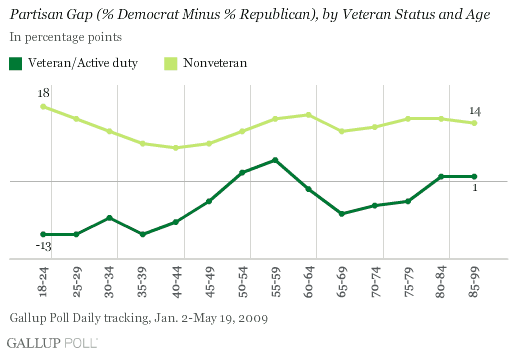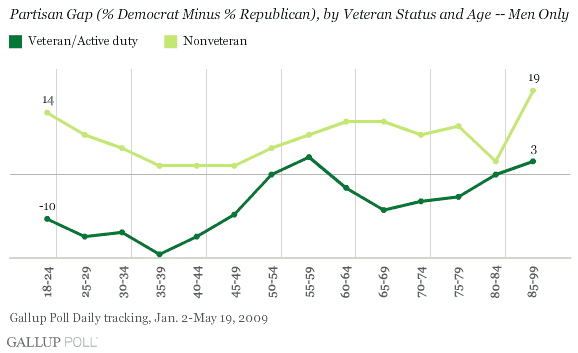PRINCETON, NJ -- Veterans are more likely to be Republican than are those of comparable ages who are not veterans. This Republican skew is at least minimally evident across all age groups, ranging from a 15-point difference in the percentage Republican between veterans and nonveterans in the 25-29 age group, to a 2-point difference in the 85+ group.

These results are based on an analysis of more than 138,000 interviews conducted as part of the Gallup Poll Daily tracking program since January of this year. Respondents were classified as veterans/active military based on an affirmative response to this question: "In the past or at the present time, are you or have you been a member of the United States military?" Fourteen percent of Americans indicate that they have served in the military in the past or are currently on active duty. (It should be noted that normal survey procedures would not include active-duty military serving overseas or on ships at sea.)
Ninety-one percent of those who have served in the military at some point in their lives are men. Looked at differently, over one-quarter -- 27% -- of men aged 18 and older say they are veterans or currently serving in the military, compared to just 2% of adult women.
The basic distribution of current or past military service among men in this country is remarkably differentiated by age. Veteran status is just slightly above 10% for men under age 35, rises slightly among men between 35 and 54, and then begins to rise sharply among men 55 years of age or older. Veteran status levels off at about the 50% mark among men in their 60s, and rises again after that age point, peaking at the 70%+ level among men now aged 80 or older.

These trends correspond directly to the status of the draft and wartime environment in which men came of age.
The military draft officially ended in 1973. This means that men who today are roughly aged 55 and younger were for the most part not subject to the draft. For men currently 56 and older, on the other hand, the draft was very much a reality as they reached age 18. So, too, was a series of international conflicts that required a large military, including the Vietnam War, the Cold War, the Korean War, and, for the oldest group, World War II. The high incidence of military service among these older men documents the degree to which military service in those eras was much more universal than it is today.
Political Differences
For the entire adult population, 34% of veterans and those currently on active military service are Republican, compared to 26% of those who are not veterans, while 29% of veterans identify themselves as Democrats, compared to 38% of those who are not veterans. (Thirty-three percent of veterans are independents, compared to 29% of nonveterans.)

It has been well documented that there are major generational differences in the political orientation of Americans across age groups today. Still, the current analysis shows that regardless of the underlying patterns of political identification that pertain at each age group, veterans (or those currently in the military) of all ages are more Republican and less Democratic than those who are not veterans.

The accompanying graph displays the "net partisan gap" (% Democratic identity minus % Republican identity) of veterans and nonveterans at each age group. This gap value is lower among veterans than nonveterans at all age groups -- meaning that veterans are less Democratic and more Republican in orientation. The difference in these "net partisan gap" values ranges from a high of 31 points among those 18-24 to a low of 10 points among those 50-54.
Since more than 9 out of 10 veterans are men, and since men as a group skew more Republican and less Democratic than women, it is possible that some of the differences are the result of the comparison of a largely male population of veterans with a mixed-gender population of nonveterans. But an analysis of the differences in partisan gap among men only (that is, comparing male veterans to male nonveterans at each age group) shows that the partisan differences persist.

Different Patterns at Work?
It is difficult to establish the precise causal relationship between military service and Republican orientation. It may be that service in the military per se socializes an individual in certain ways that in turn lead to a more Republican viewpoint -- either at the time or in later years. On the other hand, there may be a selection factor at work, such that individuals already disproportionately Republican in orientation are more likely to join the military, meaning that the causal factor predates actual military service.
The latter explanation seems more reasonable for the younger age cohorts considered in this research. For the most part, Americans who are now aged 55 and under, as noted, volunteered to serve rather than having been drafted. Under these conditions, a reasonable hypothesis seems to be that more conservative/more Republican persons would be disproportionately represented in the ranks of volunteers, suggesting that the major reason for the observed veteran/nonveteran political difference lies in the backgrounds of those who choose to serve.
On the other hand, those who are now 56 and older were generally subject to the draft and presumably had a lot less choice in whether they served. That would be particularly true for Americans now 70 and older, among whom the majority are veterans. Here a more reasonable hypothesis may be that the socialization process that took place as part of military training and service, coupled with the impact such service has on an individual's reflection on politics and policy later in life, had a greater impact on the observed more Republican orientation among these veterans.
No doubt both processes are at work to at least some degree across the age spectrum. Whatever the cause, the data are clear: having served in the military is associated with a more Republican and less Democratic political identity.
Survey Methods
Results are based on telephone interviews with 138,049 national adults, aged 18 and older, conducted Jan. 2-May 19, 2009, as part of Gallup Poll Daily tracking. For results based on the total sample of national adults, one can say with 95% confidence that the maximum margin of sampling error is ±1 percentage points.
Interviews are conducted with respondents on land-line telephones (for respondents with a land-line telephone) and cellular phones (for respondents who are cell-phone only).
In addition to sampling error, question wording and practical difficulties in conducting surveys can introduce error or bias into the findings of public opinion polls.
